LECTURE RESOURCES: Read this lecture in Team-GPT, it is interactive and contains notes and comments from the author.
Any chat with the AI is as good as the Goal, Context, and Persona.
Therefore, these are the first 3 things we talk about in our methodology because they’re really important.
Table of contents
Setting Clear Goals for ChatGPT
The Goal is always required.
ChatGPT is based on a model called ‘InstructGPT’.
It literally expects instructions and performs best when you provide them.
Provide it with instructions by using verbs like: create, translate, draft, rephrase, write, summarize, and so on.
Another way to define a goal is to ask a question like: what, why, how.
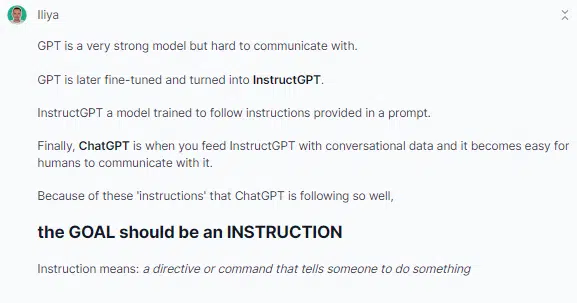
Context is Key
Context is always required, too.
Every new chat starts from scratch. ChatGPT doesn’t remember anything you’ve said in a different chat.
The fact that yesterday you had a great chat, doesn’t mean anything. ChatGPT simply doesn’t know about it.
Therefore, you need to always, always provide context.
Use as many details as you can.
Simply imagine you’re explaining it to another person for the first time.
Remember: Usually, we don’t like when ChatGPT replies to have adjectives (OUTPUT), but we really like to prompt with adjectives! (INPUT)
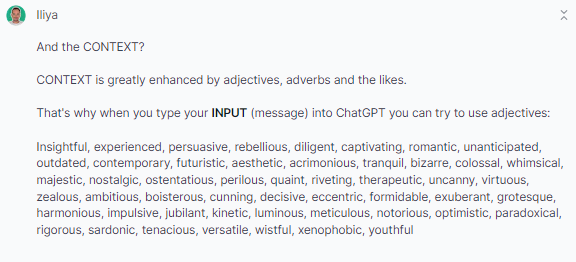
Defining a Persona for Better Context
Defining a persona is optional, not because it is not important.
It is just not applicable every time. I need it in about 50% of my chats.
The rule is: use whenever it can improve the context. A persona is just a lot of context with few words.
Save the top 5 personas you’ve had most success with.
Just write them down or save them as prompts in Team-GPT.
The 3 big ones: Goal, Context, Persona.
Every time you start a new chat make sure you’ve got the 3 big ones: Goal, Context, Persona.
Don’t be lazy.
Be committed to helping ChatGPT understand you better and it will.
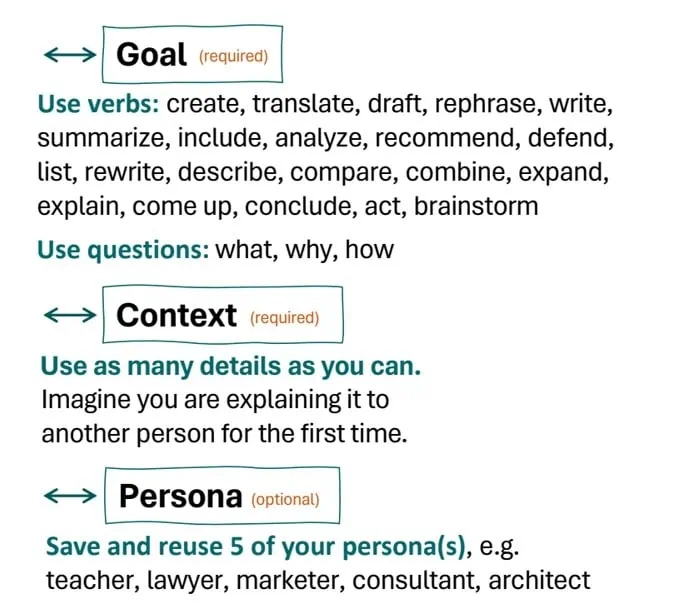
Techniques to Improve ChatGPT’s Responses
These were the fundamentals that always apply.
However, you never get the best answer from the first time.
You need to improve the results somehow.
Here are the most common techniques:
- Regenerate response is the most common one. Whenever you don’t like the result, try regenerating and it might be way better.
- If the conversation is not going well, start a new chat and try prompting differently.
- Provide examples. This is very important, and we will have a separate lecture on it.
- Add constraints whenever needed, for instance, ‘start a sentence with the word: Team-GPT’
- Asking the AI to change the tone from professional to friendly or vice versa is also often needed
- Don’t stop iterating. Try adding more context. Try coming up, other ways to express yourself. Iterate until you find the right approach.
- Using a ‘prompt creator’ is always a possibility. A prompt creator is a prompt that help you create other prompts. It might take time but for hard tasks it can really help.
- Break the big text into smaller texts and explore part by part. Paragraph by paragraph is usually enough. GPT is smart but it is not human.
- Ask for a different perspective on a topic. It is always interesting to see
- Break down into smaller bits. Never tackle problems that are too big in one prompt.
- If you expect a certain type of format, just instruct ChatGPT to show it.
There are many other techniques, too. Some have fancy names, others not.
After thousands of chats, these are the ones that I use most often.
💡 This lesson is a part of the ChatGPT for Work course
The course is interactive, if you take it inside the Team-GPT platform.
ChatGPT for Work: The Interactive Course contains:
• 100+ tried and tested prompts
• 100+ exercises
• 100+ extra notes and comments
• 1000s of use cases
• PDFs files for later reference
It is also completely FREE.
Start today and become a ChatGPT expert in less than 7 days!
Follow-Up Prompts
Finally, the last part: ‘copy-paste these prompts’. I call these ‘follow-up’ prompts.
ChatGPT is never perfect from the get go.
Use these prompts to iterate on unsatisfactory replies from ChatGPT.
I use these 11 all the time. They are not special in any other way. They simply work for me.
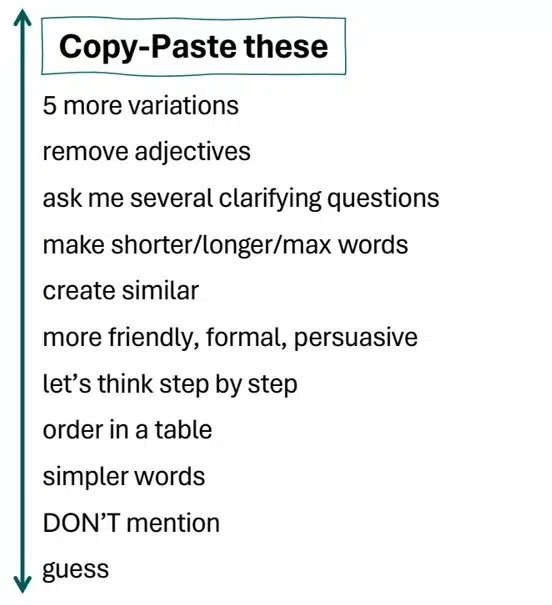
If you find other good follow-ups, let your colleagues know.
Share the knowledge with them.
Revisiting the Process
Let’s go through the prompting methodology once again.
- You start a chat.
- Define the goal, provide the context. Use a persona, when relevant.
- Apply the above-mentioned techniques to prompt better.
- Iterate on results by copy-pasting these prompts.
Please DO These Often
- Ask GPT for whatever problem you have at work. This is how you’ll learn: by interacting.
- When in doubt, break down big tasks into smaller tasks. Don’t overestimate the AI.
- Often fact check on Google. It is easy to start trusting ChatGPT too much.
Do NOT Do These
- Don’t stop using ChatGPT. The world has changed forever. Whoever can’t utilize ChatGPT will simply be worse off.
- DO NOT trust ChatGPT blindly. ChatGPT works based on probabilities and literally ‘guesses’ every answer. Be careful!
- Do NOT share secrets. ChatGPT doesn’t care but your employer and bad actors might. You can get into serious trouble if you share secrets.
Final Words to Remember
Let’s be old-fashioned.
If you have access to a printer, print this out:
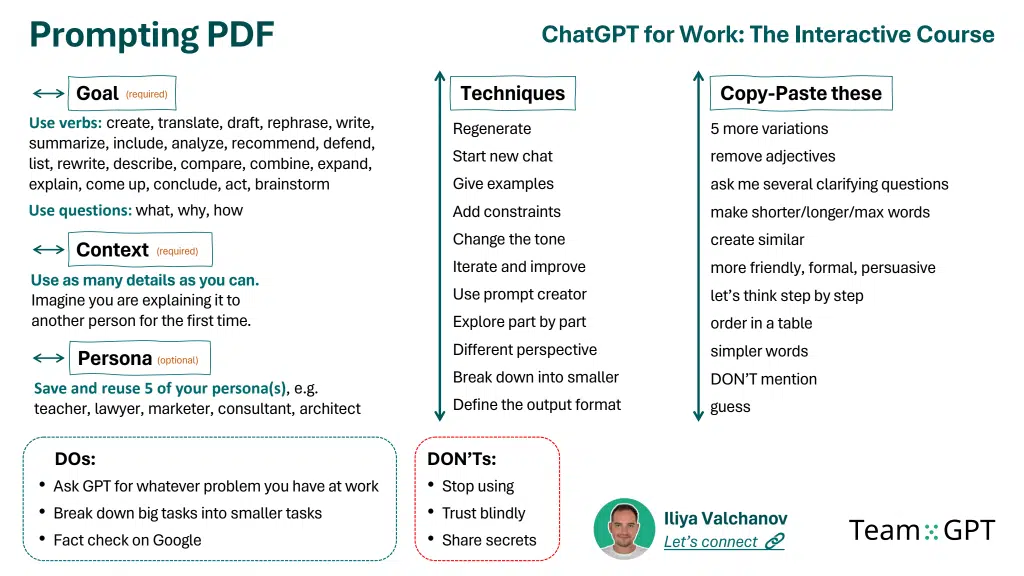
Put it next to your desk.
Refer to it until you learn to use ChatGPT.
Good luck!
